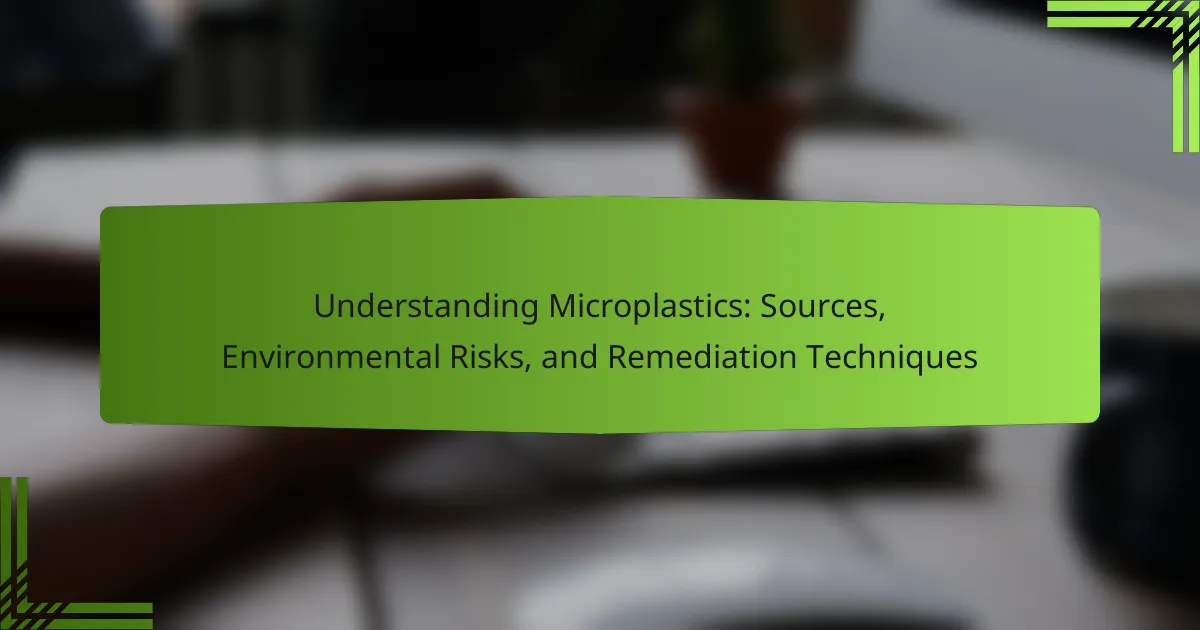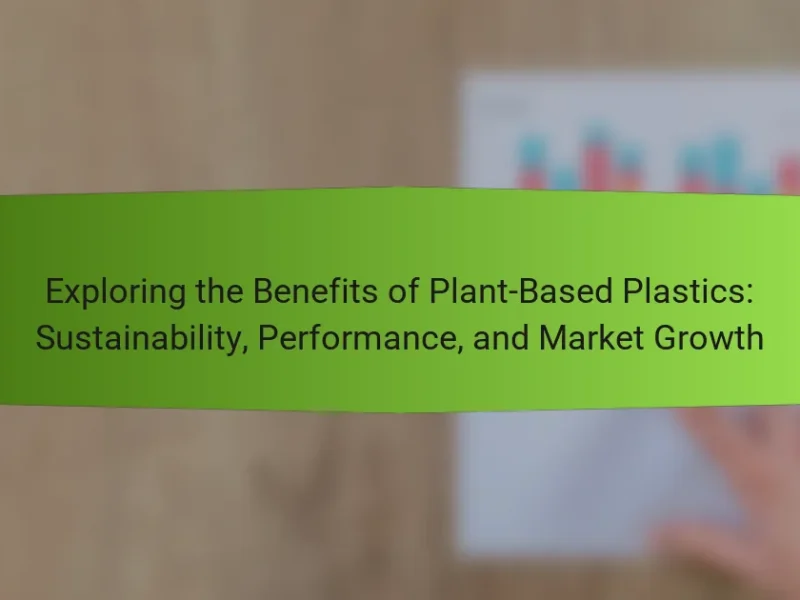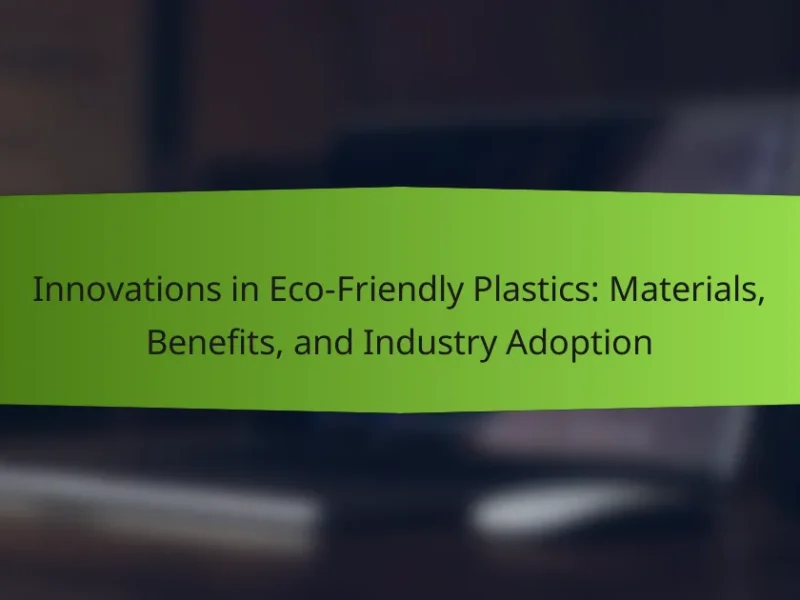Microplastics are defined as small plastic particles measuring less than 5 millimeters, resulting from the degradation of larger plastic items and the use of microbeads in personal care products. This article explores the significant environmental and health risks posed by microplastics, including their accumulation in marine organisms and potential to carry harmful chemicals. It outlines the various pathways through which microplastics enter ecosystems, such as through the breakdown of plastic debris, synthetic textiles, and personal care products. Additionally, the article reviews available remediation techniques, including physical, chemical, and biological methods, highlighting their effectiveness in addressing microplastic pollution. Understanding these aspects is essential for environmental conservation and public health initiatives.
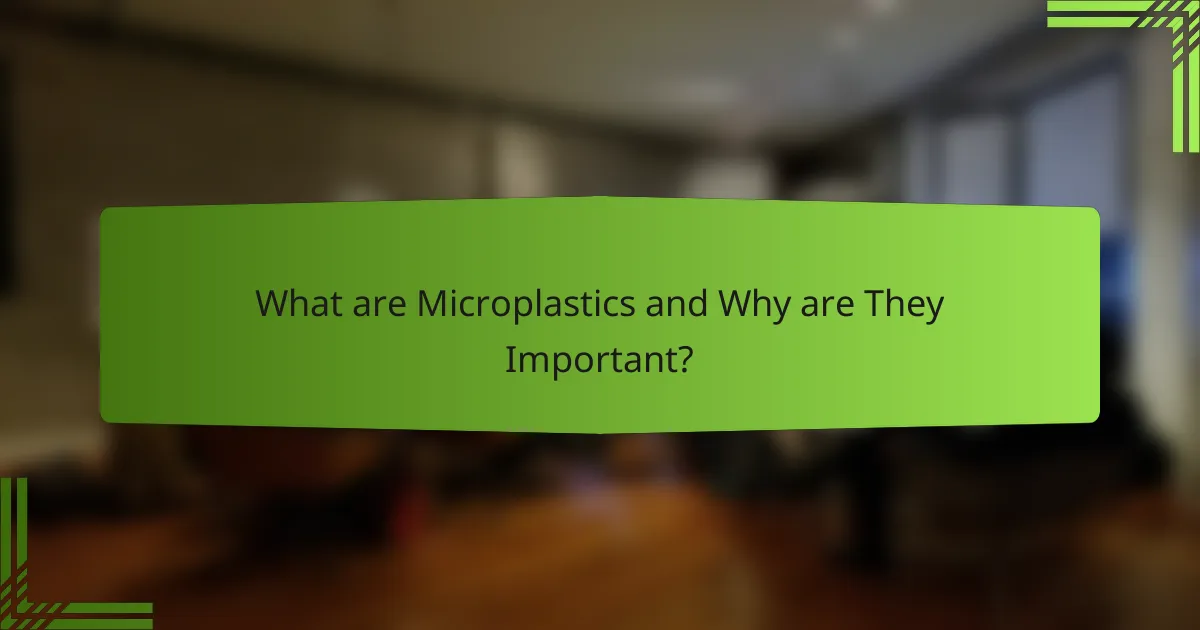
What are Microplastics and Why are They Important?
Microplastics are small plastic particles less than 5 millimeters in size. They originate from the breakdown of larger plastic items and from microbeads found in personal care products. Microplastics are important because they pose significant environmental and health risks. They can accumulate in marine organisms, leading to bioaccumulation in the food chain. Studies have shown that microplastics can carry harmful chemicals and pathogens. Research indicates that over 1.5 million tons of microplastics are released into the oceans annually. Their pervasive presence affects ecosystems and human health. Addressing microplastics is crucial for environmental conservation and public health initiatives.
How are Microplastics Defined?
Microplastics are defined as small plastic particles less than 5 millimeters in size. They originate from the breakdown of larger plastic debris or are manufactured as microbeads for various products. These particles are pervasive in the environment, found in oceans, rivers, and soil. Studies indicate that microplastics can harm marine life and enter the food chain. Research shows that they can absorb toxic chemicals, posing risks to ecosystems and human health. The presence of microplastics has been documented in various studies, highlighting their widespread distribution and potential impacts.
What are the different types of Microplastics?
Microplastics are categorized into two main types: primary microplastics and secondary microplastics. Primary microplastics are manufactured small plastic particles, often found in products like cosmetics and industrial materials. Secondary microplastics result from the breakdown of larger plastic items due to environmental factors like sunlight and mechanical abrasion. Research indicates that primary microplastics can be as small as 1 micron, while secondary microplastics can vary significantly in size. Both types pose environmental risks, as they can accumulate in ecosystems and enter the food chain.
What are the common sources of Microplastics?
Common sources of microplastics include plastic waste, synthetic fibers, and personal care products. Plastic waste breaks down into smaller particles over time. This can happen in oceans, rivers, and landfills. Synthetic fibers shed during washing clothes. Studies show that a single wash can release thousands of microfibers. Personal care products often contain microbeads, which are tiny plastic particles. These are used in exfoliating scrubs and toothpaste. Additionally, tire wear from vehicles contributes to microplastic pollution. Research indicates that tire wear particles are a significant source in urban areas.
What are the Environmental Risks Associated with Microplastics?
Microplastics pose significant environmental risks. They contaminate marine and freshwater ecosystems. Aquatic organisms ingest microplastics, leading to physical harm and toxic exposure. This ingestion can disrupt food chains and affect biodiversity. Microplastics also accumulate in sediments, impacting soil health and organisms that rely on these habitats. Their persistence in the environment makes remediation challenging. Studies indicate that microplastics can transport harmful pollutants, compounding their environmental impact. Research shows that microplastics can affect the reproductive systems of marine life, further threatening populations.
How do Microplastics impact marine life?
Microplastics negatively impact marine life by causing physical and chemical harm. Marine organisms ingest microplastics, mistaking them for food. This ingestion can lead to internal injuries and blockages. Microplastics also carry toxic chemicals that can leach into the organisms. These toxins can disrupt endocrine functions and lead to reproductive issues. Studies show that over 800 species are affected by microplastics. The presence of microplastics in food chains can have cascading effects on entire ecosystems. Additionally, microplastics can accumulate in the tissues of marine animals, posing risks to human consumers.
What are the potential human health risks linked to Microplastics?
Microplastics pose several potential health risks to humans. Inhalation or ingestion of microplastics can lead to respiratory issues and gastrointestinal problems. Studies indicate that microplastics can cause inflammation and oxidative stress in human cells. Research published in Environmental Science & Technology found microplastics in human stool samples, indicating exposure. Additionally, microplastics may carry harmful chemicals and pathogens, further increasing health risks. Long-term exposure to microplastics is still being studied for potential chronic health effects.

How Do Microplastics Enter the Environment?
Microplastics enter the environment through various pathways. They are released from the breakdown of larger plastic debris. This degradation occurs due to UV radiation, mechanical abrasion, and chemical processes. Microplastics also originate from synthetic textiles during washing. Each wash can release thousands of microfibers into wastewater. Additionally, microplastics are found in personal care products, such as exfoliating scrubs. These products often contain microbeads that wash down the drain. Industrial processes can also emit microplastics into the air and water. Research indicates that microplastics are pervasive in marine and terrestrial ecosystems. Studies show that they have been detected in oceans, rivers, and even in soil.
What are the primary pathways for Microplastics release?
Microplastics are released into the environment through several primary pathways. These include wastewater discharge, atmospheric deposition, and runoff from land. Wastewater treatment plants often fail to filter out microplastics effectively, allowing them to enter water bodies. Atmospheric deposition occurs when microplastics are emitted into the air and subsequently fall back to the ground or water. Runoff from urban areas, agricultural fields, and industrial sites can carry microplastics into rivers and oceans. Additionally, the breakdown of larger plastic items contributes to the formation of microplastics. Studies indicate that millions of tons of microplastics enter oceans annually through these pathways.
How do consumer products contribute to Microplastics pollution?
Consumer products contribute to microplastics pollution primarily through the release of tiny plastic particles during their use and disposal. Common sources include personal care items like exfoliating scrubs and toothpaste, which often contain microbeads. These microbeads are washed down the drain and enter aquatic environments. Additionally, synthetic textiles shed microfibers during washing, leading to significant microplastic contamination in waterways. A study by the International Union for Conservation of Nature estimated that 35% of microplastics in the oceans come from synthetic clothing. Packaging materials, such as plastic wrappers and containers, also degrade into microplastics when disposed of improperly. Therefore, consumer products play a critical role in the proliferation of microplastics in the environment.
What role does wastewater treatment play in Microplastics dispersion?
Wastewater treatment plays a significant role in microplastics dispersion. It can either mitigate or exacerbate the release of microplastics into the environment. Treatment processes aim to remove contaminants, including microplastics, from wastewater before it is discharged. However, not all treatment systems effectively capture microplastics. Studies indicate that conventional wastewater treatment plants capture only a portion of microplastics, allowing many to pass through. For example, a study published in “Environmental Science & Technology” found that wastewater treatment plants can release millions of microplastic particles into receiving waters. Therefore, the efficiency of wastewater treatment directly influences microplastics dispersion in aquatic environments.
Why is it critical to address Microplastics pollution?
Microplastics pollution is critical to address due to its harmful impact on ecosystems and human health. These tiny plastic particles are pervasive in the environment, found in oceans, rivers, and soil. Microplastics can be ingested by marine life, leading to bioaccumulation in the food chain. According to a study published in Environmental Science & Technology, over 800 species are affected by microplastics. Additionally, microplastics can release toxic chemicals, posing risks to human health through contaminated food and water sources. Addressing this pollution is essential to protect biodiversity and ensure safe ecosystems for future generations.
What are the long-term effects of Microplastics on ecosystems?
Microplastics have detrimental long-term effects on ecosystems. They can disrupt food chains by being ingested by marine organisms. This ingestion can lead to bioaccumulation of toxins in higher trophic levels. Microplastics also affect the reproductive systems of aquatic species. Research indicates that microplastics can alter habitat structures, impacting biodiversity. They can introduce harmful chemicals into the environment, affecting soil and water quality. Studies show that microplastics can persist in ecosystems for hundreds of years. These effects can lead to decreased ecosystem resilience and function.
How do Microplastics affect the food chain?
Microplastics disrupt the food chain by accumulating in organisms at various trophic levels. Marine species ingest microplastics, mistaking them for food. This ingestion can lead to physical harm and toxic chemical exposure. As smaller organisms are consumed by larger predators, microplastics transfer up the food chain. Research indicates that over 200 species, including fish and shellfish, have been found to contain microplastics. This contamination poses risks to human health through seafood consumption. Additionally, microplastics can alter species behavior and reproductive success. Studies show that microplastics can impact nutrient cycling in ecosystems, further affecting food availability.
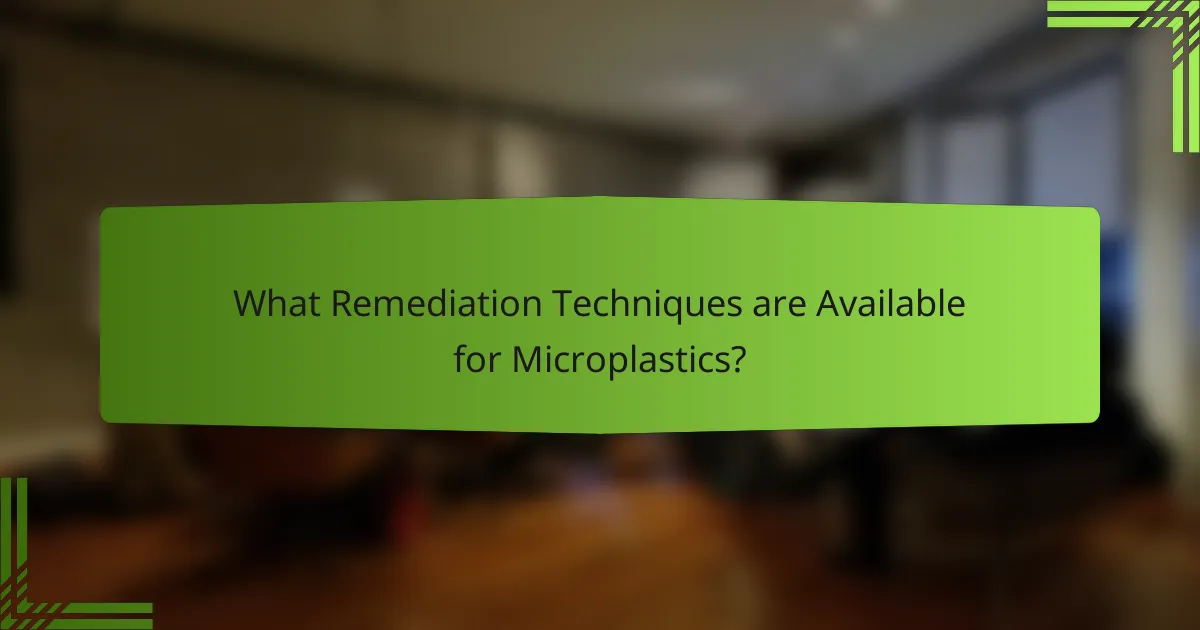
What Remediation Techniques are Available for Microplastics?
Available remediation techniques for microplastics include physical, chemical, and biological methods. Physical techniques involve filtration and sedimentation to remove microplastics from water. For instance, mesh filters can capture larger particles effectively. Chemical methods utilize agents like flocculants to agglomerate microplastics for easier removal. Biological techniques involve using microorganisms that can degrade or consume microplastics. Studies show that certain bacteria can break down plastic polymers. Each method has varying effectiveness and applicability depending on the microplastic type and environmental conditions.
What methods are currently used to remove Microplastics from water bodies?
Methods currently used to remove microplastics from water bodies include filtration, sedimentation, and chemical treatments. Filtration systems utilize mesh screens or membranes to capture microplastics. Sedimentation relies on gravity to settle larger particles, allowing cleaner water to be collected. Chemical treatments involve adding coagulants to bind microplastics, making them easier to remove. Advanced oxidation processes use reactive species to break down microplastics into smaller, less harmful components. Research indicates that these methods vary in effectiveness depending on the size and type of microplastics. For instance, a study published in “Environmental Science & Technology” found that filtration can remove up to 99% of microplastics in controlled conditions.
How effective are mechanical filtration systems in Microplastics removal?
Mechanical filtration systems are effective in removing microplastics from water. Studies show that these systems can achieve removal rates exceeding 90%. The effectiveness depends on the filter’s pore size and design. For instance, filters with pore sizes of 1 micron or smaller are particularly efficient. Research published in the journal “Environmental Science & Technology” indicates that mechanical filters can capture a wide range of microplastic sizes. This includes fragments, fibers, and beads. The removal efficiency can vary based on water flow rates and the concentration of microplastics. Overall, mechanical filtration is a viable method for mitigating microplastic pollution in aquatic environments.
What role do chemical treatments play in Microplastics remediation?
Chemical treatments facilitate the degradation and removal of microplastics from the environment. These treatments often involve the use of oxidizing agents, which break down the polymer structures of microplastics. For example, hydrogen peroxide and ozone are commonly utilized due to their strong oxidative properties. Research indicates that chemical treatments can significantly reduce the size and toxicity of microplastics. Studies have shown that using these agents can lead to a reduction of microplastic particles by over 90% in certain conditions. Additionally, chemical treatments can enhance the effectiveness of physical and biological remediation methods. This synergy improves overall microplastics removal efficiency in contaminated environments.
What innovative solutions are being developed to combat Microplastics?
Innovative solutions being developed to combat microplastics include advanced filtration systems. These systems can capture microplastics from water sources. Researchers are also exploring bioremediation techniques using microorganisms. Certain bacteria can degrade microplastics into non-toxic substances. Additionally, new materials are being designed to replace conventional plastics. These materials are biodegradable and reduce microplastic pollution. Recent studies highlight the effectiveness of these solutions in reducing environmental impact. For example, a study published in Environmental Science & Technology showed that specialized filters can remove up to 99% of microplastics from wastewater.
How can bioremediation be utilized for Microplastics degradation?
Bioremediation can be utilized for microplastics degradation by employing microorganisms to break down plastic materials. Certain bacteria and fungi have been identified that can metabolize components of plastics. For example, the bacterium Ideonella sakaiensis can degrade polyethylene terephthalate (PET), a common plastic. Research shows that these microorganisms can convert plastics into less harmful substances. This process reduces the persistence of microplastics in the environment. Additionally, bioremediation can be enhanced through optimizing conditions such as temperature and nutrient availability. Studies have demonstrated that bioremediation can significantly reduce microplastic concentrations in contaminated environments.
What role does public awareness play in reducing Microplastics pollution?
Public awareness plays a critical role in reducing microplastics pollution. Increased awareness leads to informed consumer choices. When people understand the impact of microplastics, they are more likely to reduce plastic use. Education on proper disposal methods can minimize plastic waste entering the environment. Campaigns highlighting the effects of microplastics on health and ecosystems encourage community action. Research shows that communities with higher awareness levels have lower pollution rates. For instance, a study by the United Nations Environment Programme found that public engagement significantly reduces plastic litter. Thus, raising awareness is essential for effective pollution reduction strategies.
What can individuals do to minimize their contribution to Microplastics pollution?
Individuals can minimize their contribution to microplastics pollution by reducing plastic usage. They should opt for reusable bags, bottles, and containers. Choosing natural fibers over synthetic materials in clothing can also help. Washing synthetic clothes less frequently can decrease microplastic shedding. Avoiding products with microbeads, commonly found in cosmetics, is essential. Participating in local clean-up efforts can help remove existing plastic waste. Supporting legislation aimed at reducing plastic production contributes to broader change. Educating others about microplastics raises awareness and promotes collective action.
Microplastics are defined as small plastic particles less than 5 millimeters in size, originating from the breakdown of larger plastic items and microbeads in personal care products. This article examines the sources of microplastics, including plastic waste and synthetic fibers, and their significant environmental and health risks, such as bioaccumulation in marine life and potential human health impacts. It also discusses various remediation techniques, including physical, chemical, and biological methods, and emphasizes the importance of public awareness and individual actions in reducing microplastics pollution. Addressing microplastics is critical for environmental conservation and ensuring the safety of ecosystems and human health.
